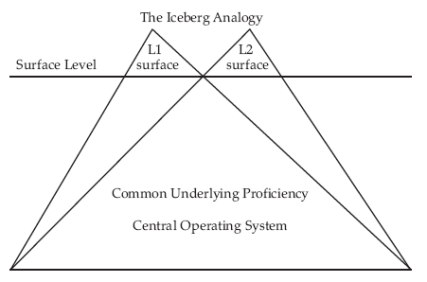Like my childhood, my favorite shows on Netflix and podcasts are full of wonderfully inventive translanguaging[1]. Translanguaging can be:
Que disfrutes el weekend.
- Convey shades of meaning or shifts in register:
I’ll do whatever me da la chingada gana.
Translanguaging serves many purposes. But as a child, the adults in my school life never signaled that using my “full linguistic repertoire” (even when I wasn’t swearing), was a strength. My multilingual identity was essentially sidelined by both monolingual and multilingual adults. I was often viewed as two different people and would present as “Mexican” me or “yanqui” me depending upon environmental cues.
When I began teaching over ten years ago, “code switching” had a bad name. Most scholarly articles and “legit” professors warned that if we translated or didn’t adhere strictly to the language of instruction, we would disappear in a noxious plume of smoke… our students would become babblers – prevented from fulfilling their linguistic potential.
Fortunately, Ofelia García and many other enlightened educators released me from my previously held beliefs about the binary nature of bilinguals. I am not multiple monolinguals occupying one brain. Mutlilingualism, in fact, makes me whole. My students’ languages, my languages don’t have to be siloed. I’m not arguing for just speaking whatever language whenever; dual language teachers can be intentional about making space for translanguaging without sacrificing time and space for each language of instruction.
So, I’ve provided all of this exposition to talk about how my fidelity to this idea of separating languages has evolved in my life and in my teaching. I’d like to unpack a recent experience in which translanguaging was humanizing for both me and other educators.
This summer, I cofacilitated a Dual Language Cognitively Guided Instruction Institute with amazing colleagues from UCLA Mathematics Project. It was the first time we had ever designed a professional development that embraced the potential of translanguaging. Doing something for the first time, in and of itself, was good reason not to try it. So initially, planning was daunting. None of the schools I have ever worked in have openly supported translanguaging – even despite current research on generative metalinguistic structures, cross linguistic transfer routines, and culturally responsive pedagogy. In fact, the Center For Applied Linguistics[2] is, only this year, cautiously supporting translanguaging as a tool for people who have exposure to and experience speaking at least two languages. This preamble is here to drive home a few points: most PDs for Spanish dual language teachers are conducted entirely in English. Most classrooms have strict schedules to separate languages. Most dual language programs choreograph contrived structures in which teachers only ever speak one language to students regardless of the wealth of languages spoken in a community.
These commonly accepted practices made planning our PD precarious. My colleagues and I were nervous that people would disparage our approach. After all, teaching is really hard. Separation of languages at least gives us the illusion of control over what can feel like chaos – the messy reality of working with children. Translanguaging means we compromise that seeming control. However, with the relinquishing of control comes a deeper understanding of the true linguistic repertoire of multilinguals. During the PD, we knew we’d have to make skillful teacher moves about when and why to draw on the whole of our linguistic experiences -otherwise the PD and the concept of translanguaging could be misunderstood as a free-for-all. In reality, embracing translanguaging entails intentional planning. If we screwed it up, our fellow educators might stick their fingers in their ears and “lalalalalalalalalala” their way out the door and back into classrooms. Classrooms in which languages are artificially separated. In which teachers unnecessarily deny their multilingualism to “convince” children to speak one language at particular times. In which monolingualism is normalized. I feared, and still fear, people’s fidelity to monolingualism – an idea and ideal that’s reinforced by the marginalization of speakers of languages other than English in our media and politics in the U.S. Planning felt subversive. Mixing English and Spanish slides in our slide deck as well as Spanish videos and English scholarly articles was new terrain for me. Encouraging participants to reflect and respond como les dio las chingadas ganas was risky. Maybe they’d think we, as facilitators, didn’t have the necessary vocabulary skills to stick to a single language. We worried participants might be confused. These are fears and concerns that teachers have had about translanguaging with children as well.
None of that happened.
What did happen was each morning meeting of this PD intentionally invited educators to share their experiences in whichever languages they wished. Yes, we mathed and we mathed hard. But our days began with acknowledgments of our identities and building relationships through language. We didn’t dip our toes into the translanguaging corriente[3], we swam in it. Our corriente was strong – not just because of rich math activities and culturally responsive protocols but because, together, we validated the many ways we use language. We delighted in Spanish synonyms – our Latinx participants had roots all over the Americas and shared a plethora of regional words and phrases. By fluidly moving between the spectrum of ALL English and ALL español, we centered ourselves. We normalized multilingualism. For us, we were simply sensemaking.
At the end of each day of PD, my insides rioted as I read the feedback… Much to my relief, the reviews were glowing! Some folks weren’t convinced that translanguaging would work for children even if they valued seeing best practices in Spanish and testing out ideas in all the languages they actually taught, thought, and dreamed in. The educators wanted more PDs in Spanish with opportunities to process and reflect in any language. So much for fidelity to old ideas! Since that PD, I have facilitated other sessions with opportunities to translanguage. Simultaneously, I’ve been reflective about protecting minority languages and offering opportunities to the emergent multilinguals in my classroom to reclaim their whole selves as just that, whole. Not fractured or broken. I hope, too, that I’ve inspired other teachers to consider the ways in which separating languages can be reductive.
Rather than blindly trusting tradition or my faulty intuitions, I am now working to create capacious spaces for communication based on ongoing data[4]. The “small data” of our daily observations is also very valid. If the teacher is a researcher, and the classroom is an ethnographic space, we can and should be open to shifting our stance. These shifts have occurred, for me, as I build relationships through language with both adults and children. In using this teacher-researcher stance, I have faith that we can dismantle interlocking oppressions through self-interrogation. As I plan PDs, and design productive learning environments for children, I ask myself: to what and to whom do we owe fidelity?
[1] The definition I will use for translanguaging in this post comes from Ofelia García, Ricardo Otheguy, and Wallis Reid: “… the deployment of a speaker’s full linguistic repertoire without regard for watchful adherence to the socially and politically defined boundaries of named (and usually national and state) languages.”
[2] The Third Edition of Best Practices For Dual Language Education (2018) discusses translanguaging in Strand 3: “Prior editions of the Guiding Principles for Dual Language Education, while stating the need to promote metalinguistic awareness and foster cross-linguistic connections, recommended monolingual lesson delivery: that is, instruction in only one language at a time.” This strand on instruction later states: “Another important point to consider is that language use and language development occur in sociocultural contexts. Several educators and researchers have focused on a cognitive-sociocultural perspective of language in developing the concept of translanguaging (García, 2015; García & Wei, 2014; Lewis, Jones, & Baker, 2012), which refers to bilinguals’ use of all the linguistic resources available to them with no artificial separation of languages. This term first emerged in the context of Welsh/English bilingualism, in which the use of Welsh was at risk, and there was a push to promote its use as much as possible. The concurrent use of Welsh and English in the classroom began, which provided for the emergence of translanguaging as a pedagogy (Lewis et al., 2012). García, Johnson, and Seltzer (2016) propose four purposes for translanguaging: 1) to provide support for students to engage and comprehend academic content; 2) to give students opportunities to engage in language practice while reading academic content; 3) to provide a space for students to further develop their bilingualism; and 4) to promote the socio-emotional development of students, especially their bilingual identities. Thus, according to this translanguaging perspective, emergent bilinguals use all their cognitive and linguistic resources during interactions, such that the content on which they draw may be distributed across languages (Hopewell & Escamilla, 2015). Instructionally, this perspective means that there is not a strict separation of languages at all times, but there can be a more fluid use of both languages strategically in the same lesson (Lewis et al., 2012).”
[3] River metaphor that Ofelia García often employs to refer to the dynamic flow of bilingualism in spaces that bilinguals occupy. Rather than a static linguistic landscape, when languages are not artificially separated, an integrated translanguaging corriente can flow.

[4] Jim Cummins discusses the common proficiency model in his research on bilinguals. He uses an iceberg analogy to suggest that two distinct icebergs or languages are visible but there is a unified processing system that both languages “contribute to, access, and use.”

